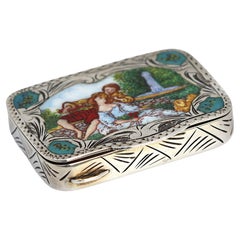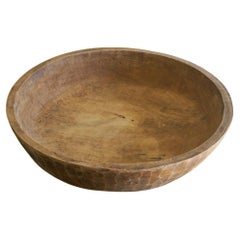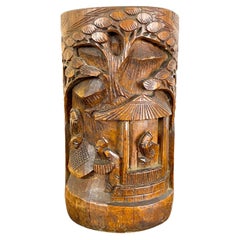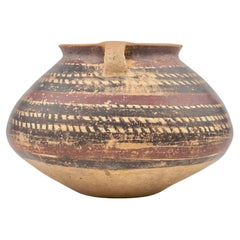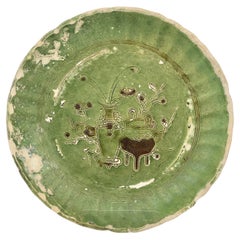Antiquities
118
1,884
10
3
to
398
760
444
1,884
1,884
1,884
7
7
4
3
3
3
2
2
2
1
1
1
1
835
580
469
228
70
47
39
4
13
6
7
17
10
6
16
3
602
509
438
268
190
1,623
1,123
779
309
303
4
4
3
2
2
Antiquities For Sale
Item type: Antique and Vintage
Italian/French Enamel and Silver Snuff Box
Located in West Palm Beach, FL
Italian/French Enamel and Silver Snuff Box.
Late 19th Century, the interior lid impressed 22, no other visible marks. The rectangular hinged box with an interior gilt wash, the lid ...
Category
Late 19th Century Antique Antiquities
Materials
Silver
Japanese Antique Wooden Bowl 1910s-1940s Primitive Wabi-Sabi
Located in Chiba-Shi, JP
This is a Japanese wooden bowl.
It is a folk craft that was used in daily life.
I don't know what kind of wood it's made of, but it's sturdy.
Despite its size, it is made from a sing...
Category
Early 20th Century Japanese Antiquities
Materials
Wood
Vase / pot à pinceau / bitong en bambou sculpté - Chine - Qing 950XIXth
Located in Beuzevillette, FR
Hand carved bamboo vase/brush pot/bitong.
This hand-carved Chinese bamboo bitong or dried flower vase dates from the late Victorian period, circa 1880.
The bitong, or brush pot, is...
Category
19th Century Chinese Victorian Antique Antiquities
Materials
Bamboo
Neolithic Yangshao Culture Pottery Amphora, 3rd-2nd Millenium BC
Located in seoul, KR
This pottery has a bulbous body with two small, protruding handles near its widest part. The pottery features horizontal bands of patterns, which include a sequence of geometric shap...
Category
15th Century and Earlier Chinese Antique Antiquities
Materials
Pottery
Green-Glazed Earthenware Dish Circa 1725, Qing Dynasty, Yongzheng Reign
Located in seoul, KR
It is the rare earthenware among those excavated from the Ca Mau Ship, and it is a green-glaze work that is especially unique. Although it is in very worn condition, it is a valuable...
Category
1720s Chinese Qing Antique Antiquities
Materials
Earthenware
Two Blue and White Miniature Vases, C 1725, Qing Dynasty, Yongzheng Era
Located in seoul, KR
During Yongzheng era, such miniatures were appreciated for their craftsmanship and aesthetic value. They were also often used in scholars' studios as part of the 'wenfang', or study ...
Category
1720s Chinese Qing Antique Antiquities
Materials
Ceramic
18th Century Chinese Censer
Located in Madrid, ES
18th Century Chinese Censer
CHINESE CENSER OF THE 18TH CENTURY
ANCIENT CHINESE CENSER OF THE 18TH CENTURY WITH SEAL AND HANDWRITTEN INVENTORY NUM...
Category
18th Century Antique Antiquities
Materials
Bronze
Riverscape Blue and White Teabowl, Circa 1725, Qing Dynasty, Yongzheng Reign.
Located in seoul, KR
The serene landscape and leisure activity of fishing are meticulously captured in cobalt blue on the porcelain's white surface, suggesting the value placed on harmony with the natura...
Category
1720s Chinese Qing Antique Antiquities
Materials
Ceramic
Blue And White Teabowl And Saucer Set Circa 1725, Qing Dynasty, Yongzheng Era
Located in seoul, KR
Graceful and simple beauty in the tea set decorated with floral patterns
Period : Qing Dynasty, Yongzheng Period
Production Date : C 1725
Made in : Jingdezhen
Destination : Netherla...
Category
1720s Chinese Qing Antique Antiquities
Materials
Ceramic
Japanese Antique Wooden Board Art Single Board Grain of wood 1940s Wabi-Sabi
Located in Chiba-Shi, JP
This is an old Japanese wooden board.
It is a single board with beautiful wood grain.
I think this was probably used for the top of the work table.
It was already in this state when...
Category
Mid-20th Century Japanese Showa Antiquities
Materials
Wood
Bert & May - Esquina Reclaimed Tiles 4.8m2 Lot (51sqft)
Located in Bradford, GB
All our reclaimed tiles are genuine antiques. We believe in investing in your interiors, and choosing reclaimed and repurposed tiles means breathing new life into tiles that have alr...
Category
Early 19th Century Spanish Antique Antiquities
Materials
Cement
Believed to be dignity tomb figures from the Ming Dynasty
Located in Chicago, IL
A pair of pottery dignitary tomb figures from the Ming Dynasty era.
Category
Late 17th Century Chinese Antique Antiquities
Materials
Pottery
Japanese Antique Wooden Bowl 1910s-1940s Primitive Wabi-Sabi
Located in Chiba-Shi, JP
This is a Japanese wooden bowl.
It is a folk craft that was used in daily life.
I don't know what kind of wood it's made of, but it's sturdy.
Since it is made by hand, it has a dist...
Category
Early 20th Century Japanese Antiquities
Materials
Wood
Japanese Antique Lacquer Hair Comb with Flowers in Gold Maki-e
Located in New York, NY
Stunning antique Japanese lacquer hair comb with a geometric petal-like background of stylized chrysanthemums and flowers done in gold and red maki-e. Possibly Edo or Meiji time peri...
Category
Mid-19th Century Japanese Antique Antiquities
Materials
Giltwood, Lacquer
Chinese Swatow Blue and White Ceramic Dish, Late Ming Dynasty
Located in seoul, KR
Famous late ming dynasty chinese blue and white porcelain plate, double phoenix, from the shipwrecked binh thuan
Period: Ming Dyn...
Category
16th Century Chinese Ming Antique Antiquities
Materials
Ceramic
Calcite on Amethyst cluster From San Eugenio, Artigas Dept., Uruguay
Located in New York, NY
From San Eugenio, Artigas Dept., Uruguay
Sharp crystal cluster in a parallel formation of scalenohedral calcite crystals on matrix with lustrous translucent grape purple amethyst c...
Category
15th Century and Earlier Uruguayan Antique Antiquities
Materials
Amethyst, Crystal, Other
Greek aryballos depicting a horse head
Located in EL CAMPELLO, ES
ITEM: Aryballos depicting a horse head
MATERIAL: Pottery
CULTURE: Greek, Corinthian
PERIOD: 7th Century B.C
DIMENSIONS: 62 mm x 55 mm diameter
CONDITION: Good condition
PROVENANCE: E...
Category
15th Century and Earlier Greek Classical Greek Antique Antiquities
Materials
Pottery
Japanese Antique Wooden Bowl 1910s-1940s Primitive Wabi-Sabi
Located in Chiba-Shi, JP
This is a Japanese wooden bowl.
It is a folk craft that was used in daily life.
I don't know what kind of wood it's made of, but it's sturdy.
Since it is made by hand, it has a dist...
Category
Early 20th Century Japanese Antiquities
Materials
Wood
Qing Ching Dynasty 1821-1850 Porcelain Enamel Double Mouth Chinese Vase
Located in Louisville, KY
This stunningly enameled porcelain vase has a double mouth opening with hand-painted images of boys playing among the vines, gourds and gourd blossoms. There is a border of bat-like ...
Category
Early 19th Century Chinese Qing Antique Antiquities
Materials
Porcelain
A Longquan Celadon-Glazed 'Dragon' Dish, Yuan Dynasty
Located in seoul, KR
The dish is decorated to the centre with a moulded appliqué dragon chasing the flaming pearl surrounded by a carved stylised foliage band at the cavetto. The moulded fluted exterior ...
Category
15th Century and Earlier Chinese Ming Antique Antiquities
Materials
Celadon
Pair of Asian Hand Carved Wooden Lanterns
Located in Redding, CT
Pair of Asian Hand Carved Wooden Lanterns. Nice decorative pair in a rich cinnabar color. This pair is not identical but very similar. Heavily carved gilt wood with amazing detail. H...
Category
Early 20th Century Chinese Chippendale Antiquities
Materials
Glass, Wood
Japanese Antique Wooden Bowl 1910s-1940s Primitive Wabi-Sabi
Located in Chiba-Shi, JP
This is a Japanese wooden bowl.
It is a folk craft that was used in daily life.
I don't know what kind of wood it's made of, but it's sturdy.
Since it is made by hand, it has a dist...
Category
Early 20th Century Japanese Antiquities
Materials
Wood
19th Century, A Set of Antique Lanna Thai Wooden Manuscript Bookmark with Stand
Located in Sampantawong, TH
A set of antique Lanna Thai wooden manuscript bookmark with stand.
Age: Thailand, 19th Century
Size of bookmark only: Length 46.5 - 53.4 C.M. / Width 3.6 - 4.1 C.M. / Thickness 1.4 ...
Category
19th Century Thai Antique Antiquities
Materials
Wood
Guardian(Half human half beast) Pottery Figure, Northern Wei-Tang Dynasty
Located in seoul, KR
This guardian figure represents a fusion of human and beast, a common motif symbolizing protection in Chinese lore. Crafted from pottery, the figure is a testament to the era's sculp...
Category
15th Century and Earlier Chinese Han Antique Antiquities
Materials
Pottery
Cizhou Lotus Carved Jar, Song-Yuan dynasty
Located in seoul, KR
This jar features a carved design, which is typical of Cizhou ware. It has a creamy white and brown color scheme, and the prominent decoration of lotus flower, which is a common motif in Chinese art and culture, symbolizing purity and enlightenment.
The carving technique involves coating the vessel with a layer of white slip (liquid clay), then carving away parts of it to create the design, revealing the darker clay body beneath. This technique allows for a strong contrast between the background and the carved motif.
Period : Song-Yuan Dynasty
Type : Jar
Medium : Cizhou Ware
Size : 21.5 cm(Height), 11cm(Mouth Diameter)
Provenance : Acquired in 1999, Hongkong
* Cizhou Ware
Cizhou is the name given to a number of stonewares, grey or buff, of varying degrees of hardness, with painted, incised or carved decoration on a clay slip. These stonewares were not only made in the region of Cizhou, Hebei Province, but in several provinces of China during the Song, Yuan and Ming periods. The great centres of production were in the north of China in the provinces of Hebei, Henan and Shanxi.
Cizhou wares seem to have been very popular, made for a clientèle of rich merchants, at a period when the paintings of famous...
Category
15th Century and Earlier Chinese Ming Antique Antiquities
Materials
Pottery
Romano-Egyptian cartonnage mummy mask depicting a female head
Located in EL CAMPELLO, ES
ITEM: Romano-Egyptian cartonnage mummy mask depicting a female head
MATERIAL: Linen and Gesso
CULTURE: Egyptian, Roman period
PERIOD: 1st Century B.C – 1st Century A.D
DIMENSIONS: 20...
Category
15th Century and Earlier Egyptian Classical Roman Antique Antiquities
Materials
Gesso, Linen
Chinese statuette of a Fat Lady
Located in EL CAMPELLO, ES
ITEM: Statuette of a Fat Lady
MATERIAL: Pottery
CULTURE: Chinese, Tang Dynasty
PERIOD: 618 – 907 A.D
DIMENSIONS: 655 mm x 265 mm x 210 mm
CONDITION: Good condition. Includes Thermoluminescence test by Laboratory Kotalla (Reference 05B101123). Includes Certificate of Authenticity from Dutch gallery
PROVENANCE: Ex Belgian private collection, acquired from Dutch art gallery
Comes with Certificate of Authenticity and Export Licence. If you are from outside the European Union, we will have to apply for the export licence again for your country, this takes 4 to 6 weeks.
Due to the fragility and size of this piece, it can only be shipped within the European Union, United Kingdom and neighbouring countries that can be transported by road by private courier (door to door).
This beautifully-finished ceramic attendant was made during what many consider to be China’s Golden Age, the Tang Dynasty. It was at this point that China’s outstanding technological and aesthetic achievements opened to external influences, resulting in the introduction of numerous new forms of self-expression, coupled with internal innovation and considerable social freedom. The Tang dynasty also saw the birth of the printed novel, significant musical and theatrical heritage and many of China’s best- known painters and artists.
The Tang Dynasty was created on the 18th of June, 618 AD, when the Li family seized power from the last crumbling remnants of the preceding Sui Dynasty. This political and regal regime was long-lived, and lasted for almost 300 years. The imperial aspirations of the preceding periods and early Tang leaders led to unprecedented wealth, resulting in considerable socioeconomic stability, the development of trade networks and vast urbanisation for China’s exploding population (estimated at around 50 million people in the 8th century AD). The Tang rulers took cues from earlier periods, maintaining many of their administrative structures and systems intact. Even when dynastic and governmental institutions withdrew from management of the empire towards the end of the period – their authority undermined by localised rebellions and regional governors known as jiedushi –the systems were so well- established that they continued to operate regardless.
The artworks created during this era are among China’s greatest cultural achievements. It was the greatest age for Chinese poetry and painting, and sculpture also developed (although there was a notable decline in Buddhist sculptures following repression of the faith by pro-Taoism administrations later in the regime). It is disarming to note that the eventual decline of imperial power, followed by the official end of the dynasty on the 4th of June 907, hardly affected the great artistic turnover.
During the Tang Dynasty, restrictions were placed on the number of objects that could be included in tombs, an amount determined by an individual’s social rank. In spite of the limitations, a striking variety of tomb furnishings – known as mingqi – have been excavated. Entire retinues of ceramic figures – representing warriors, animals, entertainers, musicians, guardians and every other necessary category of assistant – were buried with the dead in order to provide for the afterlife. Warriors (lokapala) were put in place to defend the dead, while horses/ camels were provided for transport, and officials to run his estate in the hereafter. Of all the various types of mingqi, however, there are none more elegant or charming than the sculptures of sophisticated female courtiers, known – rather unfairly – as “fat ladies...
Category
15th Century and Earlier Chinese Tang Antique Antiquities
Materials
Pottery
Chinese statuette of a Fat Lady
Located in EL CAMPELLO, ES
ITEM: Statuette of a Fat Lady
MATERIAL: Pottery
CULTURE: Chinese, Tang Dynasty
PERIOD: 618 – 907 A.D
DIMENSIONS: 645 mm x 260 mm x 180 mm
CONDITION: Good condition. Includes Thermoluminescence test by Laboratory Kotalla (Reference 04B101123). Includes Certificate of Authenticity from Dutch gallery
PROVENANCE: Ex Belgian private collection, acquired from Dutch art gallery
Comes with Certificate of Authenticity and Export Licence. If you are from outside the European Union, we will have to apply for the export licence again for your country, this takes 4 to 6 weeks.
Due to the fragility and size of this piece, it can only be shipped within the European Union, United Kingdom and neighbouring countries that can be transported by road by private courier (door to door).
This beautifully-finished ceramic attendant was made during what many consider to be China’s Golden Age, the Tang Dynasty. It was at this point that China’s outstanding technological and aesthetic achievements opened to external influences, resulting in the introduction of numerous new forms of self-expression, coupled with internal innovation and considerable social freedom. The Tang dynasty also saw the birth of the printed novel, significant musical and theatrical heritage and many of China’s best- known painters and artists.
The Tang Dynasty was created on the 18th of June, 618 AD, when the Li family seized power from the last crumbling remnants of the preceding Sui Dynasty. This political and regal regime was long-lived, and lasted for almost 300 years. The imperial aspirations of the preceding periods and early Tang leaders led to unprecedented wealth, resulting in considerable socioeconomic stability, the development of trade networks and vast urbanisation for China’s exploding population (estimated at around 50 million people in the 8th century AD). The Tang rulers took cues from earlier periods, maintaining many of their administrative structures and systems intact. Even when dynastic and governmental institutions withdrew from management of the empire towards the end of the period – their authority undermined by localised rebellions and regional governors known as jiedushi –the systems were so well- established that they continued to operate regardless.
The artworks created during this era are among China’s greatest cultural achievements. It was the greatest age for Chinese poetry and painting, and sculpture also developed (although there was a notable decline in Buddhist sculptures following repression of the faith by pro-Taoism administrations later in the regime). It is disarming to note that the eventual decline of imperial power, followed by the official end of the dynasty on the 4th of June 907, hardly affected the great artistic turnover.
During the Tang Dynasty, restrictions were placed on the number of objects that could be included in tombs, an amount determined by an individual’s social rank. In spite of the limitations, a striking variety of tomb furnishings – known as mingqi – have been excavated. Entire retinues of ceramic figures – representing warriors, animals, entertainers, musicians, guardians and every other necessary category of assistant – were buried with the dead in order to provide for the afterlife. Warriors (lokapala) were put in place to defend the dead, while horses/ camels were provided for transport, and officials to run his estate in the hereafter. Of all the various types of mingqi, however, there are none more elegant or charming than the sculptures of sophisticated female courtiers, known – rather unfairly – as “fat ladies...
Category
15th Century and Earlier Chinese Tang Antique Antiquities
Materials
Pottery
Chinese Bronze-Enamel Cloisonné Jardinere, Qing Dynasty, Jiaqing-Period
Located in Vienna, AT
Chinese enamel Cloisonné vase, bowl, jardinere, featuring a dragon depiction from Jiaqing-Period with wooden stand. Both items in excellent condition with no dents or scratches.
M...
Category
Early 19th Century Chinese Antique Antiquities
Materials
Brass, Enamel
Bronze Buddha Flame, 15 - 16th Century
Located in New York, NY
A bronze Buddha Flame or "Ushnisha", recovered from the ancient city of Sukhotai, Thailand. Circa 15-16th Century.
The Ushnisha is the three-dimensional...
Category
16th Century Thai Other Antique Antiquities
Materials
Bronze
Qingbai Bowl with carving of crane, Song Dynasty
Located in seoul, KR
The crane, a traditional symbol of longevity and auspiciousness, is prominently placed at the center, creating a harmonious and aesthetically balanced effect. The border of the dish ...
Category
15th Century and Earlier Chinese Chinese Export Antique Antiquities
Materials
Porcelain
Bert & May - Chequerboard Reclaimed Tiles 8m2 Lot (86sqft)
Located in Bradford, GB
A timeless classic, our chequerboard tile features a deep red and off-white pattern, adding a touch of versatility to any space. As with all our reclaimed tiles it has a beautifully ...
Category
Early 19th Century Spanish Antique Antiquities
Materials
Cement
Heavenly Beings Carved Limestone Stele Fragment, Northern/Eastern Wei Dynasty
Located in seoul, KR
Flying two heavenly beings depicted in the stone. They are celestial beings called an Apsara. While having the same fragment and shape, another work I uploaded exhibits small dots on...
Category
15th Century and Earlier Chinese Han Antique Antiquities
Materials
Limestone
Celadon Vase, Five Dynasties or Northern Song dynasty, 10th-11th Century
Located in seoul, KR
The form of Longquan celadon vases from the Northern Song dynasty evolved from an early design with a long neck and tapering body to a later ovoid body with a shorter neck. Over time, the glaze developed a more olive tone, and the carved decorations became more pronounced and intricate. Examples of such vases include one without a cover dated to the Yuanfeng era (1078~1085) and documented in literature, and another similar vase without loop handles preserved by the Qingyuan County Cultural Relics Bureau. An earlier example featuring loop handles and a lotus-like cover is also mentioned in historical texts.
The use of Longquan covered vases, especially as funerary jars for offerings like wine and grains, was highlighted by an inscription on a piece from the Sir Percival David Collection, London. This inscription wishes for the vessel to preserve fragrant wine for centuries, blessing the owner with prosperity, longevity, and a vast lineage, dated to the third year of the Yuanfeng period (1080). This practice was common in the regions of Southern Zhejiang and Northern Fujian. A similar celadon vase from the Linyushanren collection was auctioned at Christie’s Hong Kong, emphasizing the cultural and historical significance of these artifacts.
Period : Five Dynasties or Northern Song Dynasty
Type : Celadon, Zhejiang province
Medium : Celadon
Size : 31.5 cm(Height) x 11.5(Diameter)
Provenance : Acquired in late 1990s from Hongkong
Reference :
1) The British Museum image id - 01613270570
2) Christies New York 23–24 MAR 2023 - Important Chinese Ceramics and Works of Art - Lot 1012
(Price Range : USD 18,000 – USD 25,000 / Type : Related)
3) National Gallery of Victoria - Accession Number - AS5-1973
* Celadon from Five Dynasties (907~960) to the early Northern Song Dynasty (960~1127)
The period from the Five Dynasties (907~960) to the early Northern Song Dynasty (960~1127) marked a significant transitional phase in the development of Chinese celadon ceramics...
Category
15th Century and Earlier Chinese Ming Antique Antiquities
Materials
Celadon
Blue and White Square Box, Circa 1725, Qing Dynasty Yongzheng Era
Located in seoul, KR
This cute square box could have been used as an incense burner, and flowers could have been inserted one by one.
Period : Qing Dynasty, Yongzheng Period
Production Date : C 1725
Mad...
Category
1720s Chinese Qing Antique Antiquities
Materials
Ceramic
Italian Majolica Mandarin
Located in West Palm Beach, FL
Italian Majolica Mandarin
Colorfully painted depicting a young Mandarin seated upon a cushion, formerly mounted as a lamp. Height 26 in., Width 12 in., Depth 14 in.
Category
20th Century Antiquities
Materials
Ceramic
Tang Dynasty, Antique Chinese Pottery Standing Cow
Located in Sampantawong, TH
Antique Chinese pottery standing cow.
Age: China, Tang Dynasty, A.D. 618 - 907
Size: Length 16 C.M. / Width 6.7 C.M. / Height 11.3 C.M.
Conditio...
Category
15th Century and Earlier Chinese Antique Antiquities
Materials
Pottery
6th - 7th Century, Pre-Angkor, Antique Khmer Pottery Jar
Located in Sampantawong, TH
Antique Khmer pottery jar.
Age: Cambodia, Pre-Angkor Period, 6th - 7th Century
Size: Height 28.4 C.M. / Width 35 C.M.
Condition: Nice and condition overall (some expected degradatio...
Category
15th Century and Earlier Cambodian Antique Antiquities
Materials
Pottery
Ancient Gu Shape Blue And White Vase, Qing Dynasty, Kangxi Era, Circa 1690
Located in seoul, KR
An attractive GU vase hand painted in cobalt blue with typical kangxi flower panels painting separated by lined borders.
Period : Qing Dynasty, Kangxi Period
Production Date : 1690-1699
Made in : Jingdezhen
Destination : Netherland
Found/Acquired : Southeast Asia , South China Sea, Vung Tau ship
Size : 14cm (Height) x 8.5cm (Diameter)
Condition : Excellent
Reference : Double checked with reference to the original catalogues
1) Christies Amsterdam 1992 - Vung Tau Cargo / Christies
2) Qing Dynasty Export Blue and White from Vung Tau Cargo(淸代外销靑花瓷) / Guangxi Fine Art Publishing House
3) Asian Ceramic Found along Maritime Silk Route / National Maritime Museum of Korea
* Vung Tau Cargo Porcelain...
Category
1690s Chinese Qing Antique Antiquities
Materials
Ceramic
Antique Imperial Dzi Beads Bracelets Pair From China
Located in 景德镇市, CN
The imperial dzi beads bracelets were used by the temple monks of the royal court to ask for blessings for Emperors.
Dzi is the first of the seven treasures of the Tibetan people.
Dz...
Category
19th Century Antique Antiquities
Materials
Jade
19th Century, Rattanakosin, Antique Thai Wood Carving with Stand
Located in Sampantawong, TH
Antique Thai wood carving for high ranking monk seat with stand.
Age: Thailand, Rattanakosin Period, 19th Century
Size of wood only: Height 56.2 C.M. / W...
Category
19th Century Thai Antique Antiquities
Materials
Wood
Meiji-Era Japanese Wooden Plant Pot – Timeless Elegance for Your Greene
Located in Hamburg, DE
Introducing our unique Japanese Meiji-era elevated wooden plant pot. Crafted with exquisite attention to detail, the lower base features elegantly blackened metal with a striking wav...
Category
1880s Japanese Meiji Antique Antiquities
Materials
Metal
Han Dynasty, Antique Chinese Pottery Hu Jar
Located in Sampantawong, TH
Antique Chinese pottery Hu jar decorated with bands of raised lines and a pair of monster masks on the shoulder.
Age: China, Han Dynasty, 206 B....
Category
15th Century and Earlier Chinese Antique Antiquities
Materials
Pottery
Old Japanese concrete decorative stand/1930-1970/Bonsai stand
Located in Sammu-shi, Chiba
This is a small stand made of old Japanese concrete.
This shape is called "Makidai" and it got its name from the fact that its legs curl inward.
"Maki" = roll
"Dai" = stand
This des...
Category
Mid-20th Century Japanese Showa Antiquities
Materials
Concrete
Blue And White Vase, Qing Dynasty, Kangxi Era, Circa 1690
Located in seoul, KR
Vung Tau Shipwreck Coralized Blue Underglazed Porcelain Lidded Vase. Almost perfectly Identical piece from Vietnamese Royal Family in United States provenance have been sold at other auction in California. This stunning porcelain lidded vase is elaborately decorated in a vivid blue underglaze with an ornate scene of concubines in a flower garden. The bottom of the vase bears a conch marking in underglazed blue, is a symbol of royalty, dignity and high rank, the 'Sacred Lungs of Buddha' and spiritual authority.
Period : Qing Dynasty, Kangxi reign
Production Date : 1690-1699
Made in : Jingdezhen
Destination : Amsterdam
Found/Acquired : Southeast Asia , South China Sea, Vung Tau Ship
Reference : Double checked with reference to the original catalogues
1) Christies Amsterdam 1992 - Vung Tau Cargo...
Category
1690s Chinese Qing Antique Antiquities
Materials
Ceramic
Green and Ochre Glazed Altar Table with Offerings, Ming Dynasty, 15~16th Century
Located in seoul, KR
The table bearing pig head, rice cakes, dishes of meat, fish and fruit. Known as Mingqi, these terracotta models were customarily included in Chinese burial practices, particularly among the affluent, to aid the deceased in their journey through the afterlife. This tradition extends back to the Neolithic Period. A unique terracotta funeral table...
Category
15th Century and Earlier Chinese Ming Antique Antiquities
Materials
Pottery
Bert & May - Hierro Reclaimed Tiles 32.4m2 Lot (348sqft)
Located in Bradford, GB
Reclaimed from Southern Spain, our Hierro Reclaimed Tile has a deep ebony colour that has weathered and aged beautifully in the sun. Create a dark and striking backdrop to your space...
Category
Early 19th Century Spanish Antique Antiquities
Materials
Cement
Rare Boshan Incense Burner Yue Celadon, Jin dynasty
Located in seoul, KR
The Boshan incense burner is particularly notable among Han dynasty incense burners for its unique shape. Designed to resemble a mountain or even a mythical mountain, it is characterized by its pointed peaks that rise upwards. These peaks often function as vents for the smoke, creating an effect reminiscent of a volcanic eruption.
The body of the incense burner is typically round, with multiple small peaks surrounding a central, larger peak. The material used is mainly ceramic, although there are instances where they were made of bronze. It is presumed that this incense burner was used for religious or ceremonial purposes during its time. The colors of these burners are usually in shades of pale green or greyish brown, with the application of glaze to achieve a variety of colors on occasion.
Such incense burners are often found in tombs or ritual sites, and their purpose was to burn incense for purification of space or to produce pleasant aromas. The Boshan incense burner also represents a significant cultural heritage, showcasing the craftsmanship and artistic values of the period. Today, it is considered a quintessential example of ancient Chinese art.
Period : Han-Jin Dynasty
Type : Incense Burner
Medium : Yue celadon...
Category
15th Century and Earlier Chinese Han Antique Antiquities
Materials
Stoneware
Bert & May - Frias Reclaimed Tiles 6.2m2 Lot (66sqft)
Located in Bradford, GB
The soft colours in the Frias make it a perfect backdrop for your interior. Pair it with mid-century furniture or pops of colour. The Frias has w...
Category
Early 19th Century Spanish Antique Antiquities
Materials
Cement
Bert & May - Bodegas Reclaimed Tile - 48m2 Lot ( 516sqft )
Located in Bradford, GB
Our Bodegas tile is a reclaimed tile, found in Southern Spain. As with all of our reclaimed finds, these tiles have had a life before and have weathered and worn. The colours have a ...
Category
Early 19th Century Spanish Antique Antiquities
Materials
Cement
Han Dynasty, Antique Chinese Pottery Hu Jar
Located in Sampantawong, TH
Antique Chinese pottery Hu jar decorated with bands of raised lines and a pair of monster masks on the shoulder.
Age: China, Han Dynasty, 206 B....
Category
15th Century and Earlier Chinese Antique Antiquities
Materials
Pottery
Japanese Antique Hinamatsuri Doll 'Sannin Kanjo' Sanpo 1980s
Located in Paris, FR
This is a doll which we use for Hinamatsuri day. This person is one of Sannin Kanjo which is called Sanpo.
This person has a flower . This doll was made with plastic, cotton, silk , ...
Category
Late 20th Century Japanese Showa Antiquities
Materials
Cotton, Silk, Plastic, Wood
19th Century, Mandalay, Large Antique Burmese Wooden Flower Decoration
Located in Sampantawong, TH
Large Burmese wooden flower decoration with gilded gold.
Age: Burma, Mandalay Period, 19th Century
Size of flower only: Diameter 69.5 C.M. / Thickness 10 C.M.
Height including stand...
Category
19th Century Burmese Antique Antiquities
Materials
Wood
19th Century, Antique Laos Bronze Gong with Stand
Located in Sampantawong, TH
Antique Laos bronze gong, a kind of Laos musical instrument which produces a loud and sonorous sound. Gong stick is included.
Age: Laos, 19th Century
Size of gong only: Diameter 35....
Category
19th Century Laotian Antique Antiquities
Materials
Bronze
Green-Glazed Tripod Vessel, Han Dynasty
Located in seoul, KR
Han Dynasty green-glazed tripods are comparatively rare, especially ones that have retained their structural integrity and glaze over millennia. Pieces in good condition are scarce b...
Category
15th Century and Earlier Chinese Han Antique Antiquities
Materials
Earthenware
19th Century, Mandalay, A Set of Antique Burmese Wood Carving Pagoda Stupa
Located in Sampantawong, TH
A set of antique Burmese wood carving Pagoda.
Age: Burma, Mandalay Period, 19th Century
Size of pagoda only: Height 16.7 - 18.4 C.M. / Width 6 - 6.4 C.M.
Height including stand: 22....
Category
19th Century Burmese Antique Antiquities
Materials
Wood
Chinese Cloisonné Vase, Qing Period, 19th Century
Located in seoul, KR
Cloisonné enamel vase of baluster form and lobed sides decorated with foliage and flowers on a black background, gilt copper neck and base. Around 1900
Period: Qing Dynasty
Type: Va...
Category
19th Century Chinese Qing Antique Antiquities
Materials
Enamel
Ancient Antique Luristan Bronze Spear Early Iron Age Weapon
Located in Sampantawong, TH
Ancient Luristan bronze spear with excellent green patina.
Luristan bronze comes from the province of Lorestan, a region of nowadays Western I...
Category
15th Century and Earlier Persian Antique Antiquities
Materials
Bronze
